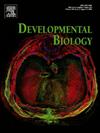At early stages of heart development, the first and second heart fields are a continuum of lateral head mesoderm-derived, cardiogenic cells
IF 2.5
3区 生物学
Q2 DEVELOPMENTAL BIOLOGY
引用次数: 0
Abstract
Pioneering work in the chicken established that the initial development of the heart consists of two stages: the quick assembly of a beating heart, followed by the recruitment of cells from adjacent tissues to deliver the mature in-and outflow tract. Cells to build the primitive heart were dubbed the first heart field (FHF) cells, cells to be recruited later the second heart field (SHF) cells. The current view is that these cells represent distinct, maybe even pre-determined lineages. However, it is still unclear where exactly FHF and SHF are located at different stages of development, and whether there is a sharp boundary or rather an overlap between the two. It is also unclear whether both FHF cells and SHF cells originate from the lateral head mesoderm (LHM), whether the paraxial head mesoderm (PHM) contributes to the SHF, and where the LHM-PHM boundary might be.
To investigate this problem, we exploited the size, ease of access and exquisite anatomy of the chicken embryo and used traditional strategies as well as newly developed transgenic lines to trace the location of cardiogenic fields and boundaries from the time the first heart-markers are expressed to the time SHF cell recruitment ceases. Our work shows that both FHF and SHF stem from the LHM. We also found that FHF and SHF lack a distinct anatomical boundary. Rather, FHF and SHF are a continuum, and the recruitment of cells into the heart is a chance event depending on morphogenetic movements, the position of cells within the moving tissues, the separation of the somatic and splanchnic LHM, and the separation of the heart from the splanchnic subpharyngeal mesoderm during heart-looping.
Reconciling our and previous studies we propose that first and second heart field precursors are specified but not determined, thus relying on morphogenetic processes and local environments to realise their cardiogenic potential.

在心脏发育的早期阶段,第一和第二心野是由侧头中胚层来源的心源性细胞组成的连续体。
在鸡身上的开创性工作证实,心脏的最初发育包括两个阶段:快速组装一个跳动的心脏,然后从邻近组织中招募细胞,以输送成熟的内流道和流出道。构建原始心脏的细胞被称为第一心脏场(FHF)细胞,随后被招募的细胞被称为第二心脏场(SHF)细胞。目前的观点是,这些细胞代表了不同的,甚至可能是预先确定的谱系。然而,目前尚不清楚在不同的发展阶段,FHF和SHF的确切位置,以及两者之间是否存在明显的边界或重叠。FHF细胞和SHF细胞是否都起源于侧头中胚层(LHM),旁轴头中胚层(PHM)是否有助于SHF,以及LHM-PHM的边界可能在哪里也不清楚。为了研究这一问题,我们利用鸡胚胎的大小、易于获取和精细的解剖结构,并使用传统策略和新开发的转基因系来追踪从第一个心脏标记表达到SHF细胞募集停止的心原场和边界的位置。我们的工作表明,FHF和SHF都源于LHM。我们还发现FHF和SHF缺乏明显的解剖边界。相反,FHF和SHF是一个连续体,细胞进入心脏的募集是一个偶然事件,这取决于形态发生运动、细胞在运动组织中的位置、体细胞和内脏LHM的分离以及心脏与内脏咽下中胚层在心脏环运动期间的分离。调和我们和以前的研究,我们提出第一和第二心场前体是指定的,但不是确定的,因此依赖于形态发生过程和局部环境来实现它们的心脏潜能。
本文章由计算机程序翻译,如有差异,请以英文原文为准。
求助全文
约1分钟内获得全文
求助全文
来源期刊

Developmental biology
生物-发育生物学
CiteScore
5.30
自引率
3.70%
发文量
182
审稿时长
1.5 months
期刊介绍:
Developmental Biology (DB) publishes original research on mechanisms of development, differentiation, and growth in animals and plants at the molecular, cellular, genetic and evolutionary levels. Areas of particular emphasis include transcriptional control mechanisms, embryonic patterning, cell-cell interactions, growth factors and signal transduction, and regulatory hierarchies in developing plants and animals.
 求助内容:
求助内容: 应助结果提醒方式:
应助结果提醒方式:


